A soil quality index for subtropical sandy soils under different Eucalyptus harvest residue managements
Jackson Freitas Brilhante de São José·Maurício Roberto Cherubin·Luciano Kayser Vargas ·Bruno Brito Lisboa·Josiléia Acordi Zanatta·Elias Frank Araújo·Cimélio Bayer
Abstract Eucalyptus harvest residues are attractive energy production resources for the forestry industry.However,their removal can have adverse impacts on soil quality and forest productivity,especially in sandy soils.In this study,we assessed the effects of Eucalyptus harvest residue managements with variable intensity on forest productivity and on physical,chemical,and biological indicators of the soil quality.The experiment was conducted in a Quartzipsamment (33 g kg-1 clay) planted with Eucalyptus saligna in Barra do Ribeiro in southern Brazil.Before the Eucalyptus was planted,residues from the previous rotation were subjected to five different management treatments:(1) FRM,in which all forest residues (bark,branches,leaves,and litter) were allowed to remain on the soil and only trunk wood was removed;(2) FRMB,in which was identical to FRM except that bark was also removed;(3) FRMBr,in which only trunk wood and branches were removed;(4) FRR,which involved removing all types of residues (bark,branches,leaves,and litter);and,(5) FRRs,in which all forest residues from the previous rotation were removed,and leaves and branches from the new plantation were prevented from falling onto the soil surface using a shade net.Six years after planting,soil samples were collected at four different depths (0-2.5,2.5-5,5-10,and 10-20 cm) to determine 17 soil chemical,physical,and biological indicators.The results were combined into a soil quality index (SQI) using the principal component analysis approach.The SQI reduced by 30%,in the 0-20 cm layer,due to removal of harvest residues from the previous rotation,and collection of litter before it falls on the ground.The main drivers of SQI reduction were the principal components associated with soil organic matter and biological activity.Furthermore,the SQI was positively linearly related to tree height at P < 0.01 and to tree diameter at breast height at P =0.07.The adverse impact on soil quality and forest productivity in our study indicates that removal of Eucalyptus harvest residues from sandy soils should be avoided.
Keywords Forest residues·Soil health·Soil organic carbon·Microbial biomass·Soil conservation
Introduction
Forest plantations cover approximately 274 Mha in the world (FAO 2020),of which about 20 Mha is planted withEucalyptus(Booth 2013).In Brazil,planted forests account for 9.55 Mha,of which 7.47 Mha areEucalyptustrees (Iba 2021).In Rio Grande do Sul,the southernmost Brazilian state,the forest area covers 1.03 Mha,in whichEucalyptusplantations represent about 65% of this area (Agef lor 2020).The predominance ofEucalyptusplantation is associated with the increasing demand for wood (Rezende et al.2014).
The sustained increase in planted forest area in tropical and subtropical Brazil (Iba 2021) has raised the need to assess the impact of this land use on soil quality and forest productivity to ensure environmental and economic sustainability.In Brazil,planted forests are usually established on low-fertility soil (Gonçalves et al.2002),which makes trees strongly dependent on nutrient cycling from litter and harvest residues (Souza et al.2016).However,the amount of harvest residues present on the soil surface can be dramatically reduced by full-tree harvesting practices (Malinovski et al.2002) and the removal of forest residues for energy production (Achat et al.2015;Gustavsson et al.2015;Baker et al.2018).These management practices can have considerably adverse impacts on soil fertility (Huang et al.2013;Kumaraswamy et al.2014;Mendham et al.2002,2014;Menegale et al.2016),microbial community (Maillard et al.2018;Mushinski et al.2018),microbial activity (Chaer and Tótola 2007),mesofauna (Rousseau et al.2018),and organic C stock (Epron et al.2006;Epron et al.2015;Rocha et al.2018;Souza et al.2020) in addition to leaving the soil surface bare and erodible (Wichert et al.2 018).In agricultural soils,the impact of management practices on soil quality and plant productivity depends on soil texture,in which sandy soils are the most vulnerable (Reynolds et al.2007;Huang and Hartemink 2020).
Physical,chemical,and biological properties can be integrated into a soil quality index (SQI) which represents the ability of soil to perform its functions (e.g.,sustaining plant and animal productivity while maintaining and/or improving air and water quality) in a given ecosystem (Karlen et al.1997;Doran and Parkin 1994;Vezzani and Mielniczuk 2009).Although no universal methodology for estimating SQI exists (Cherubin et al.2016;Rinot et al.2019),multiple linear regression (Biswas et al.2017),pedotransfer functions (Xu et al.2017),experts’ opinion,farmers’ experience (Andrews et al.2002,2004;Lima et al.2011;Tesfahunegn et al.2011),and principal component analysis (PCA) (Armenise et al.2013;Sánchez-Navarro et al.2015;Cherubin et al.2016) are especially useful for this purpose.PCA,for example,allows large amounts of data to be dimensionally reduced to facilitate selection of specific indicators by classifying correlated soil attributes into groups (so-called “principal components”,PC).
Soil quality indices are commonly used to assess the impacts of fertilization (Das et al.2016),soil management systems (Raiesi and Kabiri 2016;De Paul Obade 2017),cover crops (Sof i et al.2016;Gura and Mnkeni 2019),land uses (Cherubin et al.2016;Chaves et al.2017;Yu et al.2018),restoration of degraded lands (Pulido et al.2017;Sione et al.2017;Borges et al.2019;Ruiz et al.2020),and management of agricultural residues on agricultural soils (Urra et al.2018;Lisboa et al.2019;Cherubin et al.2021a).However,few integrated studies have employed SQI to assess the impact of harvest residue management on forest soils (Chaer and Tótola 2007;Rocha et al.2018) and,especially,in sandy soils.
Our hypothesis was that removal of harvest residues would have negative impacts on the soil quality,and consequently,reduce forest productivity in sandy soils.To test this hypothesis,we conducted a field experiment aiming to:(1) assess the impact of removing harvest residues from the previousEucalyptusrotation on chemical,physical and biological indicators of soil quality;(2) develop a sensitive,accurate protocol for establishing a soil quality index to manageEucalyptusharvest residues;(3) identify sensitive indicators of soil quality;and,(4) correlate SQI withEucalyptusproductivity in a sandy soil in southern Brazil.
Material and methods
Study site
The experiment was conducted in the municipality of Barra do Ribeiro (30° 23' S,51° 07' W) in southern Brazil.The prevailing climate as per Köppen classification is humid subtropical (Cfa),and the area has an average annual rainfall of about 1400 mm and no drought season.The average temperature of the warmest month never exceeds 25 °C and that of the coldest month,14 °C,with slight frosts.The soil at the site is an Arenosol (IUSS 2015),or Neossolo Quartzarênico,according to the Brazilian Soil Classification System (SiBCS) (Santos et al.2018),with coarse texture (sand);weak structure;and low water storage capacity (Reichert et al.2016),cation exchange capacity (Tables 1 and 2),and productive potential (Cavalli et al.2020).
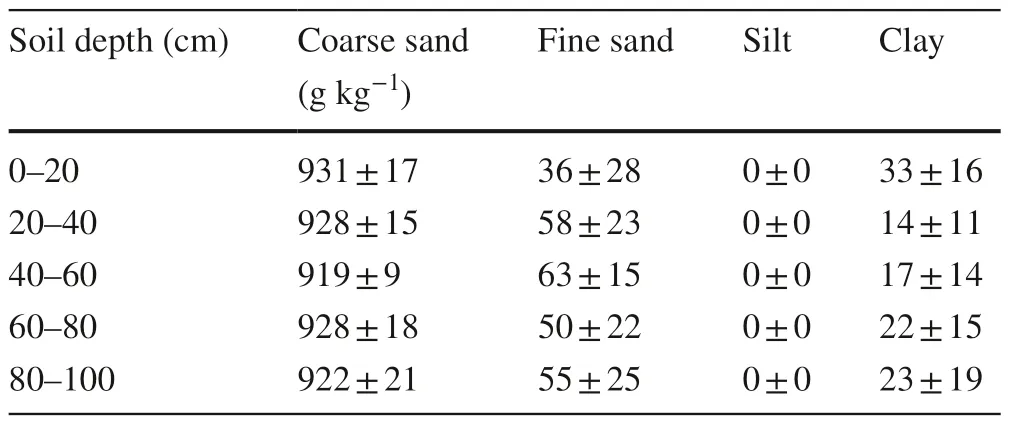
Table 1 Characterization of the soil particle-size fraction distribution of the experimental area in a sandy soil in southern Brazil

Table 2 Characterization of the soil chemical properties at the beginning of the field experiment in a sandy soil in southern Brazil
The land has been planted with eucalyptus trees since 1987,production cycles ranging from 7 to 8 year in length.In 2003,the existing plantation was harvested,and the area replanted withEucalyptus saligna,which was harvested by clear cutting in 2010-the year the study site was established.The clearcut harvest was performed in a single pass,using a Komatsu Harvester (HV) PC200-8 model equipped with tracks,110 kW (148 HP) power and weighing 24 Mg.Logs were forwarded with a Komatsu Forwarder (FW) 895 model,with extra-wide tires,193 kW power (262 HP),mass of 18 Mg and load capacity of 20 Mg,in two passes.
Experimental design and treatments
The experiment was established in 2010,using the speciesEucalyptus saligna(clone 2864).Plot size was 30 × 30 m,and each plot was used to plant 100 trees (10 rows × 10 plants).Five different treatments were applied,in quadruplicate,as established with a randomized block design.Measurements were made in an inner subplot consisting of 6 rows × 6 plants (18 × 18 m) each.The fvie eucalyptus residue management treatments were as follows:
(1) FRM:All residues (i.e.,barks,branches,leaves,and the litter layer from the previous rotation) were allowed to remain on the soil and only trunk wood were removed.
(2) FRMB:Same as FRM,except the barks were also removed.
(3) FRMBr:All residues except trunk wood and branches were allowed to remain on the soil.
(4) FRR:All residues were removed.
(5) FRRs:Same as FRRs,but litter from the new plantation was prevented from falling onto the soil surface by using a shade net.
Site management
In 2010,Eucalyptus salignatrees were clear-cut and the soil was prepared by subsoiling to a depth of 0.4 m with a ripper for application of the different treatments.The soil was supplied with baseline,topdressing,and maintenance fertilizer.Baseline fertilization involved adding 12 kg N ha-1,60 kg P2O5ha-1,and 12 kg K2O ha-1to all plots on the same day in a small pit next to each seedling.Topdressing fertilization was done by applying 24 kg N ha-1,40 kg K2O ha-1,and 4 kg B ha-1around seedlings within the ground area covered by the canopy 3 and 6 months after planting.Finally,maintenance fertilization supplied 72 kg N ha-1,and 72 kg K2O ha-112 months after planting.The experimental area was kept weed-free with glyphosate as needed.The area has no known history of burning and the harvest residues were kept on the soil surface.
Soil sampling and indicators
The soil was sampled in July 2016,before the harvest,to assess the impact of the above-described treatments on a set of chemical,physical,and biological indicators of soil quality.For this purpose,a trench was dug in the central inner subplot of each plot (specifically,in the intervening space between trees).Samples were collected from the 0.000-0.025,0.025-0.050,0.050-0.100,and 0.10-0.20 m soil layers in both walls of the trench and mixed to obtain a composite sample for analysis.
Soil chemical indicators
Once in the laboratory,soil samples were dried to constant weight in an oven with forced air circulation at 45 °C and then sieved (2 mm) and analyzed,according to Tedesco et al.(1995),for pHwaterin 1:1 suspension;exchangeable calcium (Ca2+),magnesium (Mg2+),and aluminum (Al3+) extracted by 1.0 mol KCl L-1;available phosphorus (P);and exchangeable potassium (K+).The P content was determined spectrophotometrically at 420 nm,while Ca2+and Mg2+in the extracts were determined by atomic absorption spectrometry,and K+by flame emission spectrophotometry.The cation exchange capacity at pH 7.0 (CECpH7.0) was calculated as the sum of H++Al3+,Ca2+,Mg2+,and K+(CQFS-RS/SC,2016).
Samples were also analyzed for soil organic carbon (SOC) and fractionated by physical means to determine particulate organic carbon (POC) and carbon associated to minerals (CAM).For this purpose,20 g of soil were shaken in 70 mL of a 5 g L-1sodium hexametaphosphate solution for 16 h (Cambardella and Elliott 1992).The resulting suspension was poured through a 53 μm sieve,and all CAM thus recovered was dried at 60 °C,weighed,and analyzed for carbon by dry combustion on a Shimadzu TOC-VCSH analyzer.The concentration of POC was calculated as the difference between SOC and CAM.
Soil biological indicators
Microbial activity and microbial biomass carbon
The overall microbial respiratory activity (MA) of the soil was assessed by measuring cumulative changes in CO2over 30 days of incubation at 25 °C in the dark (Stotztky 1965).The microbial biomass carbon (MBC) was analyzed with the method of Horwath et al.(1996),which involves chloroform fumigation and incubation.Nonfumigated samples were also used to determine the overall respiratory activity of the soil as described above.
Soil mesofauna
Mesofauna was extracted from undisturbed soil samples collected in metal cylinders 7 cm diameter × 7.5 cm deep (volume,288.5 cm3).Samples were extracted immediately after collection,using the modif ied Berlese-Tullgren funnel method (Edwards and Fletcher 1971).Soil cores were placed into collecting funnels under dimmer controlled 40 W light bulbs with modulated light intensity and controlled temperature (38 ± 4 °C).The bulbs dried and warmed the samples to make the animals move downwards and fall through the sieves into the funnels,which led them into collecting vessels containing 20 mL of preserving solution (70% alcohol and 1% glycerin).Mesofauna was examined under a stereoscope (40×) and a microscope with phase contrast.Based on their significance and proportional domain in soils,mites (Acari) and springtails (Collembola) were also considered.
Soil physical indicators
Undisturbed soil samples were used to determine soil bulk density (BD),total porosity (TP),soil degree of compaction (SDC),and structural stability index (SSI).BD and particle density (Dp) were determined volumetrically,the former with the ring method and the latter with the balloon method (Embrapa 1997).TP (m3m-3) was calculated as 1 -BD/Dp(Mg m-3),and SDC (%) as BD/BDmax(Mg m-3) × 100,where BDmaxis the maximum bulk density as estimated with the pedotransfer function [BDmax(Mg m-3)=2.03133855-0.00320878 × soil organic mattercontent (g kg-1)-0,000,076,508 × clay content (g kg-1);r2=0.95;P< 0.001] of Marcolin and Klein (2 011).Finally,SSI (%) was calculated according to Reynolds et al.(2007),i.e.,as {[SOC (g kg-1) × 1.724]/[silt (g kg-1)+clay (g kg-1)] × 100.
Soil quality
The effects of the eucalyptus harvest residue treatments on soil quality were evaluated following the three-step procedure described by Cherubin et al.(2016).In the first step,a minimum dataset of 17 indicators was selected for soil quality assessment.The selection was based on expert opinion and literature review.The minimum dataset included nine chemical (pH,P,K+,Ca2+,Mg2+,Al3+,H++Al3+,SOC,and POC),four physical (BD,TP,SDC,and SSI),and four biological indicators (MA,MBC,mites,and springtails).
The second step of the process involved the linear transformation of data to rank each indicator by using a scoring curve based on the relation between the indicator and a given soil function used to evaluate soil quality (SQ).Curves were constructed according to two contrasting criteria depending on the particular indicator,namely:(a) “the more,the better”,in which the higher the measured value,the higher (better) the score (e.g.,the higher SOC,the better SQ);and (b) “the less,the better”,whereby the lower the measured values,the higher (better) the score (e.g.,the lower BD indicated better physical conditions for plant growth and thus better SQ).The measured values of each indicator were transformed into unitless values ranging from 0 to 1.The maximum score value (score=1) was attributed to FRM management system,considered as the reference treatment.
Finally,in the third step,transformed data were integrated into a single dimensionless value:a SQI.For that,PCA was used to estimate the “weight” of each indicator in SQI.The index was calculated from the weights (eigenvalues) of each of the five main components and the correlation (eigenvector) of each indicator as follows:

For this,each indicator was multiplied by its weight (α,β,ƹ) on each principal component (PC1-PC5) deemed significant according to Kaiser’s criterion (i.e.,eigenvalue > 1) and then multiplied by the proportion of total variance explained by each PC.
Data analysis
Data were checked for normality with the Shapiro-Wilk test atP> 0.05 and subjected to PCA by using the PROC FACTOR procedure in SAS.An analysis of variance (ANOVA) was performed with the PROC GLM procedure to assess the effects of each treatment on soil attributes and SQI.If theF-statistic of the ANOVA was significant (P< 0.05),then means were compared using Fisher’s LSD test atP< 0.05.All statistical procedures were done with the SAS v.9.4 software package.In addition,linear regressions were used to better understand the relationship of SQI to tree height (TH) and tree diameter at breast height (DBH).To estimate these parameters,we measured 36 trees from each plot,at the soil sampling date.
Results
Impact of eucalyptus harvest residues (HR) on soil quality indicators
Effects on chemical indicators
The removal of eucalyptus harvest residues and litter did not alter (P> 0.05) soil chemical indicators in the 0-20 cm layer (Table 3).
Effects on physical indicators
Soil physical changes (0-20 cm) were detected according to the eucalyptus harvest residues and litter were managed (Table 3).BD ranged from 1.38 to 1.48 Mg m-3and increased by about 7% when all types of residues (bark,branches,leaves,and litter from the previous rotation) were removed and litter from the new plantation avoided(treatment FRRs).A similar effect on SDC was also observed,in which removing all HR and litter increased soil compaction from 68 to 73%.There were no differences in TP or SSI among treatments.
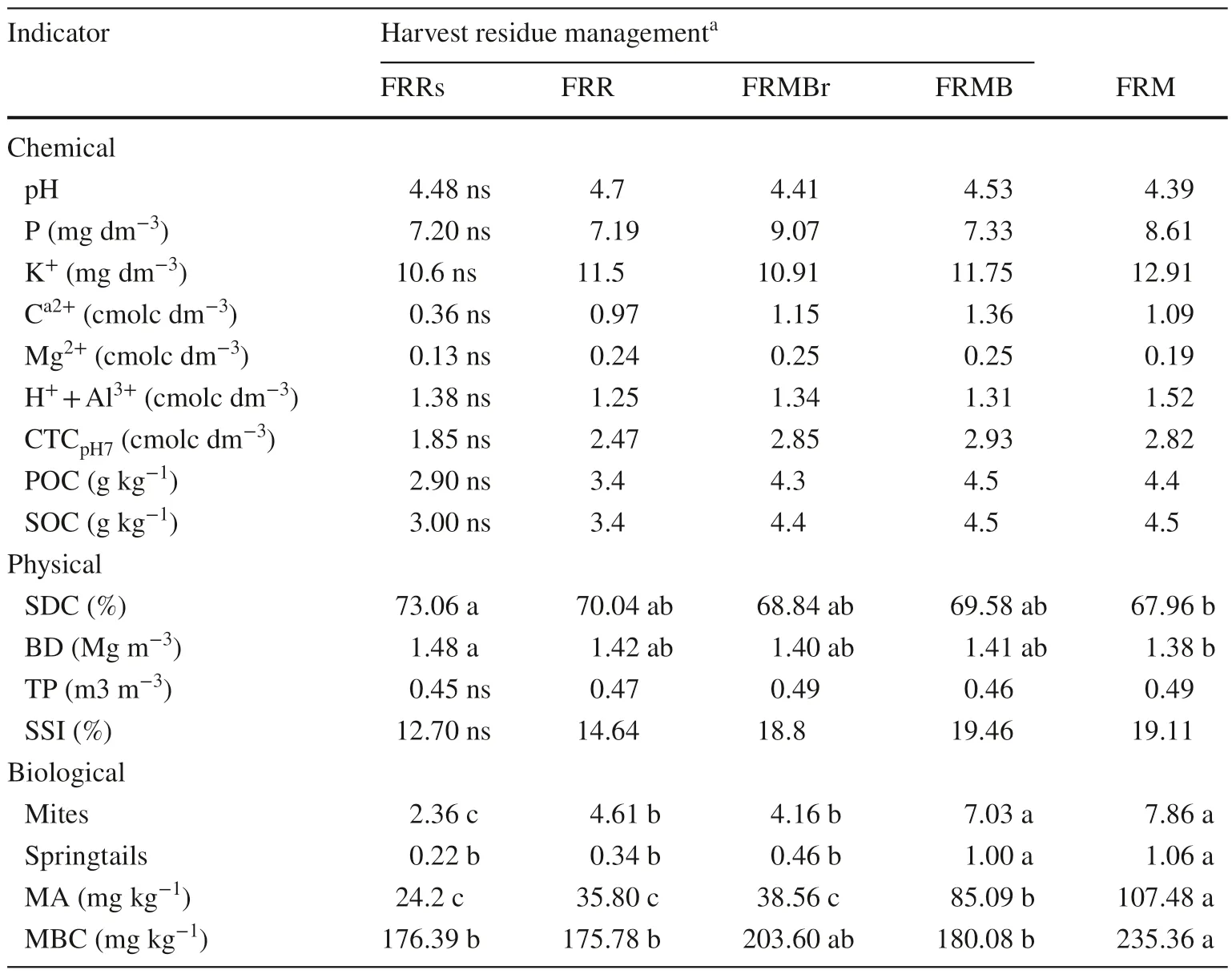
Table 3 Mean values of the 17 soil indicators (0 -20 cm depth) under different eucalyptus harvest residue management in a sandy soil in southern Brazil
Effects on biological indicators
Soil microbial respiratory activity ranged from 24.2 to 107.4 mg C-CO2kg-1soil in the 0-20 cm soil layer.The highest levels corresponding to treatment FRM and the lowest to FRRs (i.e.,removing all eucalyptus HR and litter from the new plantation decreased five-times MA relative to their retention).Moreover,the MA decreased as additional components including branches,bark,leaves,and litter were removed from the soil surface.A similar effect was also observed in MBC,which was 25% lower with FRRs than it was with FRM (176.39 vs 235.36 mg C-CO2kg-1soil).
Overall,removing all HR and avoiding litter from the new plantation (treatment FRRs) significantly decreased the presence of mites and springtails (P< 0.05;Table 3).Thus,treatments FRRs and FRR diminished mite populations by 69% and 41%,respectively,and springtail populations by 79% and 67%,respectively,relative to no removal (FRM).
Soil quality index (SQI) and forest productivity
The 17 chemical,physical,and biological indicators examined were integrated into a single SQI to assess the influence of the harvest residue treatments by using PCA and scoring functions (Andrews et al.2004).Through the PCA,five principal components (PC1-PC5) with eigenvalues ≥ 1 (Kaiser’s criterion) were retained and used to calculate the SQI (Fig.1;Table 4).Collectively,they explained 87.93% of the total variance in the data.Thus,PC1 accounted for 29.33%,PC2 for 17.28%,PC3 for 17.06%,PC4 for 15.75%,and PC5 for 8.49%.

Table 4 Results of principal component analysis of soil quality indicator values under eucalyptus harvest residue management in a sandy soil in southern Brazil
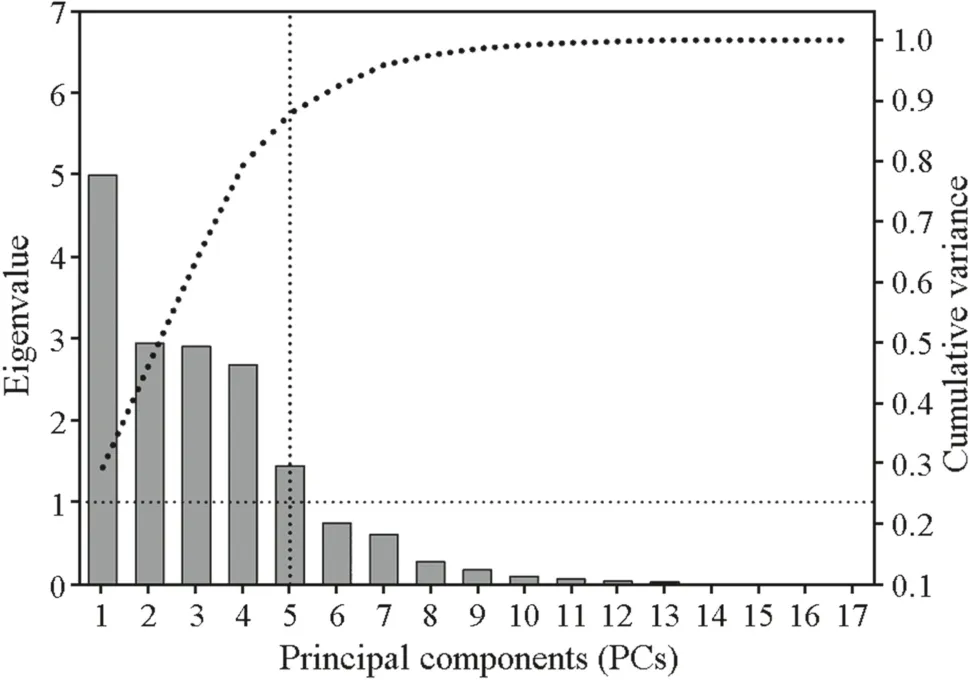
Fig.1 Scree plot of principal component analysis
The PC1 was associated with SOC,POC,and SSI,which had the highest factor loadings (0.92) for the three variables.PC2 was associated with TP and SDC,with a negative factor loading (-0.78) for SDC and a positive one (0.92) for TP.PC3 was related to pH,Mg2+,and Ca2+with a loading of 0.92,0.89,and 0.71,respectively.PC4 encompassed mite population,springtails,and MA,all with positive loadings,and P content had a high loading (0.75) in PC5.Communality exceeded 0.85 for all soil variables except P (0.67),K+(0.69),and MBC (0.65).
Overall,SQI in the 0-20 cm layer ranged from 0.75 to 1.08 (Fig.2 a),and the highest values were found in FRMB (1.08) and FRM (1.00).Removing branches (treatment FRMBr) decreased SQI relative to FRM and FRMB;however,the differences were not statistically significant.Similarly,SQI with FRRs (0.75) was about 30% lower than it was with FRMB.The greatest contributor to the reduction in SQI with treatment FRRs was PC1,which was related to SOC and equal to 0.34;in contrast,PC1 for FRMB was 0.49 (Fig.2 b).PC2,which was associated with soil physical indicators,also contributed to the reduced SQI with FRRs,which was 0.16 as compared with 0.20 in FRMB.
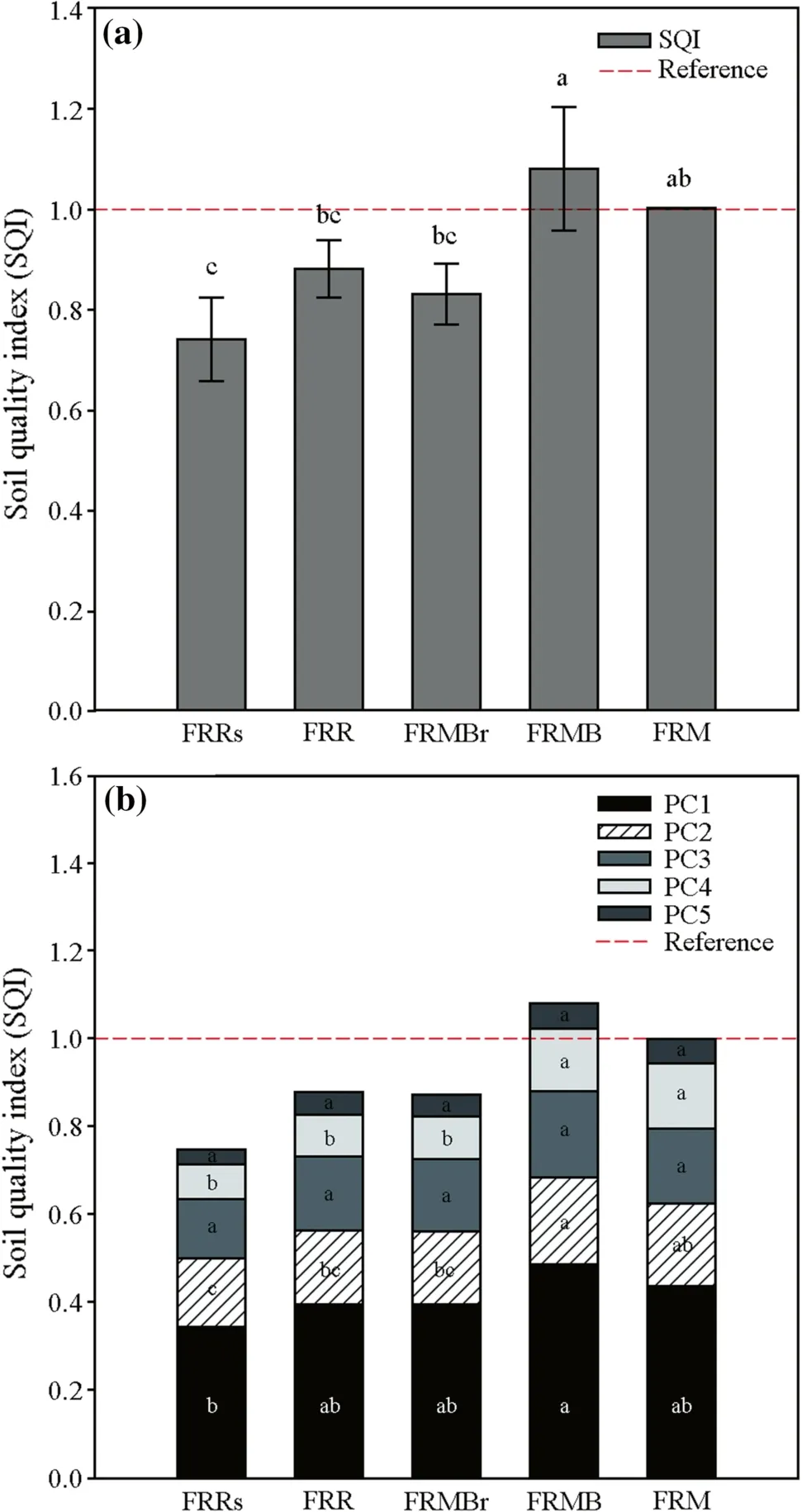
Fig.2 a Soil Quality index (SQI) under different eucalyptus harvest residue management strategies and b contribution of each principal components (PC) on SQI
FRM:all residues (i.e.,barks,branches,leaves,and the litter layer from the previous rotation) were allowed to stand on the soil and only trunk wood were removed;FRMB:same as FRM except that barks were also removed;FRMBr:all residues except trunk wood and branches were allowed to stand on the soil;FRR:all residues were removed;FRRs:same as FRRs but litter from the new plantation was prevented from falling onto the soil surface by using a shade net.Means with different letters are different by LSD fisher (P< 0.10).
Forest productivity,evaluated by DBH and TH,was influenced by the harvest residue managements.The highest value was found in FRM treatment,while the lowest value was obtained in FRRs treatment.
The SQI was linearly correlated with TH (r=0.92;TH=16.668+3.95·SQI;P< 0.01) and DBH (r=0.69;DBH=14.281+2.526·SQI;P< 0.10).Therefore,removing eucalyptus harvest residues from the soil surface decreased soil quality and reduced TH and DBH.
Discussion
Effects on chemical indicators
The results revealed high active acidity and low nutrient availability in the soil,regardless of eucalyptus residue management.These poor chemical conditions for plant growth are typical of sandy soils in Brazil (Donagema et al.2011;Santos et al.2018).The lack of differences in chemical indicators among treatments can be ascribed mainly to the factthat only one rotation cycle was examined,because other factors,such as slow mineralization of nutrients added by the residues,massive absorption of nutrients by the trees,and the low capacity of sandy soils to retain nutrients in the top layer (0-20 cm) may also have been influential (Silva et al.2013).
Despite the absence of significant changes in the availability of soil nutrients induced by the treatments (Huang et al.2013;Kumaraswamy et al.2014;Mendham et al.2014),the maintenance of harvest residues contributes as a source of calcium,magnesium,potassium,and phosphorus for plants.However,these four nutrients were present at below critical levels in the soil (viz.,0.7 cmolcCa dm-3,0.16 cmolcmg dm-3,75 mg K dm-3,and 6.4 mg P dm-3(CQFS-RS/SC,2016).Furthermore,H+Al+levels exceeded 1.52 cmolcdm-3,and pH was around 4.5,which were all unlikely to harm eucalyptus trees (Silva et al.2004).As the eucalyptus plantation was only 6 years old,the lack of differences in soil nutrient availability among treatments may have at least partly resulted from a portion of cycled nutrients being previously absorbed by the trees and,the remainder,lost by leaching,which is an important process in sandy soils (Oliveira et al.2002;Laclau et al.2005;Gómez-Rey et al.2008;Sitthaphanit et al.2009;McMahon et al.2019).Even in the absence of differences in the soil,the trees in those areas where HR were retained were probably better nourished-and hence more productive.In fact,not removing eucalyptus HR is a common practice of forest management industries to preserve or even improve soil chemical properties (Leite et al.2010).
Eucalyptus residue removal managements did not influence SOC or POC contents (Table 3).However,contents were lower than 4.5 g kg-1,which falls in the low-fertility class for SOC (Ribeiro et al.1999).This is because soils with low clay contents provide little physical protection for organic matter against microbial decomposition (Yost and Hartemink 2019;McDonough and Vadakattu 2010).More than 90% of all SOC was in the form of POC because the soil had too low of a mineral surface area for C stabilization (Zinn et al.2005).
Effects on physical indicators
Removing eucalyptus harvest residues from the previous rotation and excluding litter from the new one (treatment FRRs) resulted in a slight soil compaction,as suggested by the increased BD and SDC values relative to treatment FRM (Table 3).This was mainly due to the removal of residues which makes the soil more prone to compaction (Silva et al.2007;Cherubin et al.2021b) by allowing its surface to dissipate part of the pressure from machinery traffic in the area (Solgi et al.2018;Labelle and Jaeger 2019),and resulting in the breakdown and dispersion of aggregates (Johnson et al.2016;Blanco-Canqui and Lal 2009).In any case,soil BD was below the critical threshold for root growth in sandy soils,which is 1.75 Mg m-3(Reichert et al.2009).Therefore,the presence of eucalyptus residues and litter on the soil surface may have attenuated soil compaction.These results are consistent with those found in other studies where removing harvest residues diminished physical quality in soils under other different land uses,such as sugarcane plantations (Castioni et al.2018) and maize fields (Blanco-Canqui 2013;Tormena et al.2016).Few studies have addressed the effects of harvest residues on physical soil indicators in forest areas.In one,Jesus et al.(2015) evaluated the impact of variable machinery traffic intensities associated with different eucalyptus harvest residue management practices.They observed that machinery traffic on bare soil (no residues) degraded soil physical quality,by increasing BD and soil penetration resistance and reducing porosity and hydraulic conductivity.
Effects on biological indicators
Removing harvest residues reduced MA and MBC under FRRs,possibly because the resulting low carbon supply from the treatment dramatically reduced microbial populations and their activity.The low MA and MBC values obtained were a result of the low availability of substrate for microbial activity in those areas from which harvest residues were removed (Rocha et al.2018).This condition also possibly reduced microbial functional diversity by diminishing microbial enzyme activity in the carbon,nitrogen,and phosphorus cycles (Maillard et al.2018).Our results reveal an adverse impact of treatment FRRs on MA and MBC consistent with those of previous studies on eucalyptus in other Brazilian regions (Chaer and Tótola 2007;Rocha et al.2018) and in Australia (Mendham et al.2002; 2014).
Mite and springtail counts were greatest with treatment FRM and lowest with FRRs (Table 3).Our results are consistent with those of Rousseau et al.(2018),who found that intensive removal ofPinus banksianabiomass reduced species richness in soil mesofauna.However,the abundances of mites and springtails observed in our study were less than those typically obtained in eucalyptus plantations (Gimenes-Rieffet al.2016).The reduction in soil mesofauna with FRRs may have resulted from increased exposure of the soil surface in the absence of a cover,as well as decreased food supply and shelter availability for soil organisms.Zagatto et al.(2019a) found greater diversity of organisms in native forest soils than agricultural crop areas.They ascribed this result to an increased diversity of habitats and niches leading to greater uniformity and richness in mesofauna groups.
Mite and springtail development is favored by management systems that supply organic residue inputs from organic fertilizers and plant remains (Kautz et al.2006).In contrast,bare sandy soils are especially susceptible to changes in temperature and moisture,and they tend to have smaller populations of mesofauna (Rovedder et al.,2009).This effect was previously observed by Zagatto et al.(2019b) in pure and intercropped plantations ofEucalyptus grandisandAcacia mangium.They found the soil mesofauna orders were correlated with soil moisture,the largest populations being those in soil underAcacia mangiumcontaining the greatest amounts of litter.
Soil quality index (SQI) and forest productivity
Overall,SQI was sensitive to the changes induced by the treatments.The highest SQI values were found in FRMB (1.08) and FRM (1.00) (Fig.2).These results suggest that FRMB treatment sustained similar soil quality as FRM even 6 years after tree barks were removed.This unexpected result can be explained in various ways.First,although FRMB supplied fewer residues than FRM,both treatments contributed identically to PC1 for SQI (Fig.2 b) due to low C protection and stabilization in sandy soils (Wan et al.2018;Yost and Hartemink 2019).Second,even with barks removed,the volume of harvest residues supplied by FRMB sufficed to cover the soil surface,and hence to regulate soil temperature-and facilitate soil moisture retention and microbial activity as a result (Gholz et al.2000).On the other hand,removing branches (treatment FRMBr) decreased SQI relative to FRM and FRMB.SQI was also 30% lower with FRRs (0.75) than with FRMB.
The greatest contributor to SQI reduction with treatment FRRs was PC1,which was related to SOM;thus,PC1 was only 0.34 with FRRs and 0.49 with FRMB (Fig.2 b).PC2,which was associated with physical soil indicators,contributed to SQI reduction in FRRs (0.16 versus 0.20 with FRMB).Management practices using a permanent soil cover help restore SOM,consequently improving the quality of sandy soils (Reichert et al.2016).Nevertheless,removing eucalyptus harvest residues and litter reduced the contribution of PC1,which was related to SOM and soil biological indicators-and hence to SQI.The raw data were similar among treatments,and differences were only observed when SOC data were subjected to a linear transformation.
Our results revealed an adverse impact of removing harvest residues and litter on SQI in a eucalyptus rotation.The negative effects on soil quality and forest productivity are likely worse after successive rotations.Rocha et al.(2018) concluded that removal of eucalyptus harvest residues in two consecutive rotations reduce SOM and,especially,the labile fraction affected by soil management practices.
Our results strengthen the significance of SOM and biological indicators for the sustainability of forestry activities,as removing forest residues decreases SOM and reduces MA in soil (Wu et al.2011;Mendham et al.2014;Nambiar and Harwood 2014;Mendham et al.2014).It is more difficult to revert these effects on SOM in the short term (especially in sandy soils) compared to nutrient def iciencies,which can be corrected through fertilization (Rocha et al.2016a).These results conf irm the hypothesis that factors related to SOM and biological indicators are potentially the most sensitive to detect SQ changes induced by management practices for eucalyptus harvest residues in sandy soils.
The sustainability of agricultural systems has been evaluated using SQI (Andrews et al.2002;Urra et al.2018;Gura and Mnkeni 2019;Saurabh et al.2 021) under different types of fertilization (Sharma et al.2018) or forest species (Liu et al.2018;Shao et al.2020),and used in reclaimed mining areas (Borges et al.2019;Ruiz et al.2020).Similar to our study,most researchers found the best results (i.e.,the highest SQI values) to be provided by land uses and management practices that supply organic matter to the soil and maintain crop residues on the soil surface.
Although few studies have examined the effects of removing harvest residues on eucalyptus growth and productivity in Brazil,this practice usually decreases productivity,probably by degrading some chemical,physical,and biological properties of the soil (Paes et al.2013;Rocha et al.2016b).The results of this work conf irm that eucalyptus productivity is dependent on soil quality.In the 0-20 cm layer,SQI-which encompasses soil physical,chemical,and biological indicators-was positively correlated with TH (r=0.92;TH=16.668+3.95·SQI;P< 0.01) and DBH (r=0.69;DBH=14.281+2.526·SQI;P=0.07).Previous studies revealed correlations between SQI and productivity in wheat and maize (Masto et al.2007;Mei et al.2019),rice (Bhaduri et al.2014;Liu et al.2015),and forest systems (Liu et al.2018).Therefore,SQI can be a useful tool to assess sustainability of eucalyptus production in sandy soils.
Conclusion
Removing eucalyptus harvest residues did not alter the nutrient contents of a sandy soil after a 6-year rotation cycle.However,it resulted in soil physical and biological degradation,as suggested by the increased BD and reduced MA.Based on SQI values,removing eucalyptus harvest residues and litter degraded soil quality compared to preserving them (treatment FRM).
Soil quality degradation was primarily associated with depletion of soil organic matter and reduction of biological activity.TH and DBH values were correlated with SQI scores,showing that the crop residues that reduced soil quality also reduced forest productivity.The soil quality index proposed here allows changes in soil quality induced by eucalyptus harvest residue management practices in southern Brazil to be accurately identif ied and quantif ied.Therefore,it may provide a useful tool to monitor quality and sustainability in eucalyptus production.
Retaining eucalyptus harvest residues is essential to avoid degradation of soil quality and losses of forest productivity in vulnerable soils such as sandy soils (e.g.,Quartzipsamments).Extending this line of research to other locations and different soil textures over more than one rotation is strongly advised to help conf irm our conclusions and,above all,help forest industry managers to choose the most sustainable management practices in the long term.
AcknowledgementsThe authors are grateful to CMPC for enabling assessment of the field experiment.
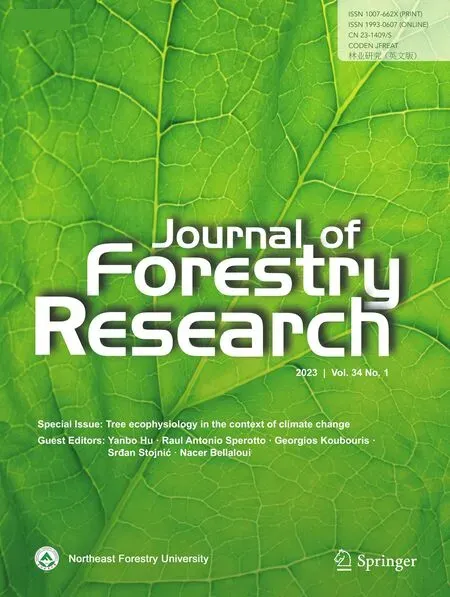 Journal of Forestry Research2023年1期
Journal of Forestry Research2023年1期
- Journal of Forestry Research的其它文章
- Journal of Forestry Research
- Tree ecophysiology in the context of climate change
- Leaf thermal tolerance and sensitivity of temperate tree species are correlated with leaf physiological and functional drought resistance traits
- Modelling the impacts of cover crop management strategies on the water use,carbon exchange and yield of olive orchards
- Near-infrared leaf reflectance modeling of Annona emarginata seedlings for early detection of variations in nitrogen concentration
- Light intensity and hydrogel soil amendment differentially affect growth and photosynthesis of successional tree species
